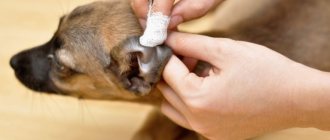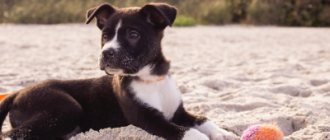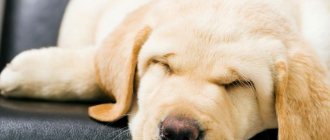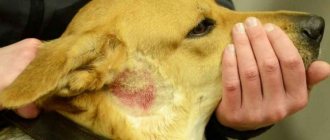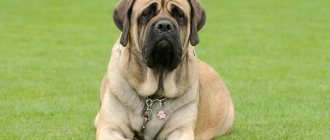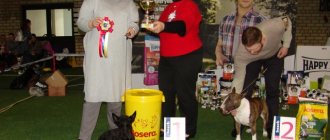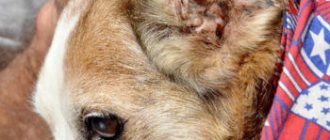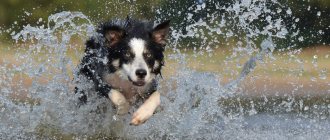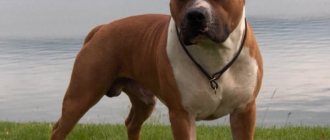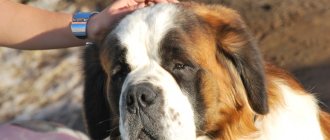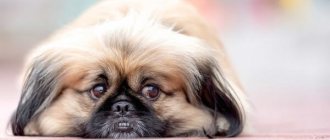brief information
- Country of origin: Germany, Baden-Württemberg, city of Leonberg.
- FCI class: group 2 (Pinchers, Schnauzers, Molossians, Swiss Cattle Dogs, etc.). Standard No. 145 dated September 20, 2002
- Purpose: guard dog, family dog, companion.
- Main color: all shades of red with a mandatory black mask.
- Life expectancy: 9-12 years.
- Average weight: from 40 to 75 kg, males are larger than females.
- Height: males from 70 to 85 cm, females from 65 to 80 cm.
- Cost: from 30,000 to 70,000 rubles.
Photo: pexels.com
Lion from the world of dogs - Leonberger: description of the breed, photo, weight and standard
He is distinguished by his proportional build, self-confidence, calmness and, at the same time, a very lively temperament.
Historical reference
The Leonberger dog breed is one of the types whose appearance and character are the result of long-term work by breeders, and not natural selection. In addition, this is a breed of local origin: it is based on aboriginal dogs from one province of Germany.
In the late thirties and early forties of the 19th century, Heinrich Essig, a member of the city council of Leonberg, near Stuttgart, crossed a black and white Newfoundland with a male named Barry (St. Bernard) from the monastery shelter of St. Bernard.
Later a cross was made with the Pyrenees Mountain Dog. As a result, very large dogs with a dominant long coat of white color were born.
Essig sought to create a dog like a lion. It is the lion that proudly flaunts on the coat of arms of the city of Leonberg.
The first true Leonbergers appeared in 1846. They combined the excellent qualities of the original breeds, and soon these dogs, sold in large numbers throughout the world, were perceived as a symbol of the city of Leonberg.
At the end of the 19th century, Leonbergers were kept primarily as farm dogs in Baden-Württemberg. They were highly valued for their guarding and drafting abilities. During two world wars and the difficult post-war periods, the number of breeding dogs decreased dramatically.
The Leonberger of today is a wonderful family dog that meets all the requirements of modern life.
Description of the breed
FCI Standard No. 145 dated September 20, 2002 “Leonberger” Group 2 “Pinchers and Schnauzers, Molosser Swiss Cattle Dogs and other breeds.”
Section 2.2 “Dogs such as Molossians and mountain herding dogs.”
The FCI standard sets restrictions on the height at the withers:
- for males 72-80 cm (desirable height 76 cm);
- for females 65-75 cm (desirable height 70 cm).
Important proportions:
- the height at the withers relative to the length of the body is 9:10;
- The depth of the chest is approximately equal to 50% of the height of the dog at the withers.
The Leonberger breed standard includes the following traits:
| HEAD | Large, with a slightly convex muzzle, smoothly turning into a long muzzle. |
| EYES | Oval shape, medium size; from light brown to dark brown (most desirable); not deep-set or protruding; at an average distance from each other; eyelids fit tightly, without visible conjunctiva; whites of the eyes (visible part of the sclera) without redness. |
| EARS | Set high, not set back, hanging, close to the head, medium in size, fleshy. |
| TEETH | The jaws are strong; scissor bite, in which the incisors of the upper jaw tightly (without gap) adjoin the incisors of the lower jaw in front, being vertically set in the jaws; teeth in a set, i.e., 42 healthy teeth in accordance with the dental formula (the absence of M3 is allowed). Direct bite is allowed; narrowing of the fangs in the lower jaw is unacceptable. |
| NECK | Connects smoothly to the withers; rather long than short; not loaded, without dewlap or dewlap. |
| BREAST | Wide, deep, reaching at least the level of the elbows; not barrel-shaped, but rather oval. |
| PAWS | Directed straight forward (not turned either inward or outward), rounded, in a ball; arched, with black pads. Limbs are straight, parallel, moderately wide. |
| TAIL | Very well dressed, hanging straight down when standing, only slightly arched when moving, not rising above the line of the back. |
| WOOL | Hair texture – from medium soft to coarse; very abundant, close-lying, never parted, not hiding the contours of the dog, despite the thick undercoat. The coat is straight, slight waviness is allowed. On the neck and chest (especially in males), the elongated hair forms a mane, and on the back of the front and hind legs there are featherings. |
| COLOR | Yellow (lion), red, fawn, sand (pale yellow, cream), as well as all combinations of these colors, always with a black mask. The hair may be black at the end, but black is unacceptable as the main color of the dog. Lightening of the main color on the underside of the tail, collar, feathering on the front and hind legs should not be obvious, disturbing the harmonious compatibility with the main color. A small white spot or narrow blaze on the chest and white hairs on the toes are acceptable. |
How long do Leonbergers live? The average life expectancy is 10-12 years.
Character and abilities
Leonberger: A description of the breed would be incomplete without mentioning the character. A special feature of mastiffs is the ability to make decisions independently, combined with family (pack) and human orientation. Thanks to this look at “their own,” mastiffs are highly valued as companion dogs.
Modern breeds of this group are not very aggressive and are strongly attached to humans and their families. What remained was independence combined with devotion without helpfulness.
The Leonberger does not cause problems as a house dog. His kindness, especially expressed towards children, makes him a convenient companion in modern life.
He is not characterized by timidity or aggressiveness. He is a pleasant, obedient and fearless companion in all life situations. The following qualities are necessarily present in the character of a purebred Leonberger:
- self-confidence and dignity;
- moderate temperament and playfulness;
- desire to obey;
- learning ability, good memory;
- immunity to noise.
Leonbergers are good with children. Acquaintance should take place under the supervision of adults, with mandatory correction of the behavior of both.
Do not allow your child to take a position next to a dog shorter than him. And a small child cannot be left alone with any dog in any position. Walks only with adults.
In order to use the “transfer” of his pack-orientation to the person when raising a Leonberger puppy, you should not take more than one puppy into the family at once. Otherwise, they will begin to establish relationships with each other, and the owner will have to earn authority from this team.
Care and maintenance
Despite their massive size, Leonbergers are agile and resilient. They need long walks at a measured pace, preferably over rough terrain (for proper muscle development, keeping them in shape, to avoid excess weight and at the same time to “work up” an appetite).
History of the origin of the breed
In the first half of the 19th century, a member of the city council of the small town of Leonberg, Heinrich Essig, became concerned with creating a breed of dog that resembled a lion. His goal is to combine in the breed his love for animals and his hometown, on the coat of arms of which was the king of beasts. The basis was taken: a Newfoundland female and a St. Bernard male. Next, the Pyrenees Mountain Dog was used in the selection. The result is huge fluffy dogs with white and gray fur.
But the official’s goal was to create an animal that would resemble a lion in its appearance and dimensions. Selection continued, and the first red representatives of the breed appeared in 1846.
The majestic dogs were loved by representatives of the local nobility; they were used by farmers for protection and as draft power. Little Leonbergers were distributed around the world as gifts, winning people's hearts with their kindness and lack of aggression.
During the world wars, the breed experienced difficult times, almost approaching extinction. In the modern world, Leonbergers are known mainly to professionals and amateurs of the breed.
Photo: wikimedia.org
Video
* We invite you to watch a video about the Leonberger . In fact, in front of you is a playlist in which you can select and watch any of 20 videos about a given dog breed by simply clicking on the button in the upper right corner of the window. In addition, the material contains quite a lot of photos. By looking at them you can find out what Leonberger looks like.
In this article:
|
Rate the material!
[Total votes: 2 Average: 5]
Leonberger looks like a real giant, but good nature and sincerity are noticeable in his dog eyes. His strength lies not in aggression, but in his nobility and friendliness, thanks to which he wins people's hearts. We will find out how this amazing breed was formed, we will describe its characteristic external features, the features of caring for such an impressive dog, its habits and disposition.
Description of the breed
The Leonberger is a very large, muscular, but elegant dog. Giants are distinguished by their proportional build, absolute self-confidence, and a calm but not apathetic temperament. Surprisingly, huge males are calm towards other animals, rarely show aggression and get along well with children.
Standard
- proportions: it is important that the ratio of the height at the withers to the length of the body is 9:10, and the depth of the chest is about 50% of the height at the withers;
- head: the length of the muzzle and skull should be almost the same; the skin should fit snugly, without forming folds or sagging;
- skull: slightly convex, powerful, but not heavy;
- nose lobe: black;
- lips: fit tightly, black, corners do not droop;
- jaws: developed, scissor bite, but a straight one is acceptable”;
- teeth: set – 42 teeth, absence of M3 is acceptable;
- eyes: shape – oval, size – medium, color – shades of brown (preferably dark). the eyelids are tightly fitted, without visible conjunctiva. The whites should not be red;
- ears: high set, without moving back. Hanging, with a tight fit to the head. Size – medium, fleshy;
- neck: smooth connection with the withers. Long, has no dewlap or dewlap;
- chest: deep, wide, at the elbow level, oval in shape;
- belly: slightly tucked;
- tail: hangs down when standing, curved and raised when moving;
- limbs: very muscular and strong, straight;
- movements: sweeping, equally smooth at all gaits, with a large grip of the front legs and a strong push of the hind legs;
- coat: abundant coat, with thick undercoat;
- color: all shades of red, yellow (lion) with a mandatory black mask.
Rock defects
- cowardice, unmotivated aggression;
- anatomical defects (hunchback, forelimbs that are too turned out, small joint angles, etc.);
- brown nose;
- severe lip depigment;
- lack of teeth (exception – M3);
- undershot, undershot;
- coat and eye color is not within the standard;
- ring tail;
- brown paw pads;
- no black mask;
- a large amount of white fur pigment (on the paws or chest) or in unacceptable places.
View this post on Instagram
Posted by Ivaholes (@ivaholes) Aug 2, 2021 at 1:50 am PDT
Care and maintenance
Keeping a Leonberger in an apartment is impossible due to its large size. A spacious enclosure would be an ideal habitat, as the dog is well suited for guarding a private home. At the same time, the enclosure should not be the place where the dog lives permanently. He definitely needs direct contact with his owners during the day.
Leonberger care should include the following items:
- Grooming. The dog has long, thick hair that needs to be groomed daily. Hair should be combed using special devices in the form of a brush or comb to remove dead hair and prevent the appearance of tangles.
- Bathing. Usually the pet is bathed once a month, but this can be done more often if the dog gets very dirty. In the summer, the dog can be allowed to swim in rivers or lakes.
- Dental examination. The mouth should be examined for dark spots, diseases of the teeth or gums, caries, etc. To make it easier for the dog to clean his teeth, you can give him solid food, for example, carrots.
- Eye and ear care. The eyes should be examined daily for dirt. They must be wiped with a cloth slightly dampened in water at least once a week. It is also important to clean ears where wax has accumulated. Normally, they should be pink in color and not have a bad smell.
- Nail trimming. Often there is no need to do this, since the pet may not like such a procedure. It will be enough to cut the claws once a month using a nail clipper.
- Preventive treatment. The dog should be treated for ticks and fleas, which pose a danger to the pet's health. It will be difficult to regularly examine a large dog, so monthly treatment will be a good way to protect the animal from the threat.
The Leonberger must be accustomed to all procedures from a young age. It is almost impossible to train an adult dog to be calm about cleaning their ears, teeth, etc.
The pet does not require active and long walks. 1-2 hours a day will be enough for him, but in the summer the hours of walking should be reduced. The animal exhibits frost resistance due to its thick coat and for the same reason does not tolerate heat well. To protect the dog from heatstroke, the owner needs to walk with it in the shade.
Diseases and life expectancy
Leonbergers enjoy good health, but they are prone to certain diseases. These diseases include:
- Hip dysplasia. This disease can lead to lameness. If your dog's back leg is swollen, it may require immediate surgery to prevent the disease from progressing. To get tested for dysplasia, just go to any veterinary clinic where your pet will have an x-ray.
- Addison's disease. It is characterized by problems in the functioning of the adrenal glands, which is why the animal feels constant weakness, along with which comes a decrease in heart rate.
- Hypothyroidism. Impaired secretion of thyroid hormones. Manifests itself in the form of weakness, decreased intelligence, weight gain, diarrhea, and vomiting.
Leonbergers have a lifespan of 8 to 10 years, which is considered average among other dog breeds.
Feeding
Owners can give their pet commercial food or stick to natural food, both options are acceptable. Dry food combines all the beneficial substances if the brand belongs to the premium class category. This diet will help prevent the formation of tartar, since solid food will be constantly included in the dog's diet.
If the owner prefers natural products, it is important to never give them from his table, as they can lead to problems with the gastrointestinal tract. The list of permitted products includes:
- lean meat;
- boneless fish;
- vegetables to taste;
- buckwheat or rice porridge;
- cartilage.
Two-month-old puppies need to be fed up to 6 times a day, seven-month-old puppies – up to 4 times, and adult dogs will need to eat twice a day.
Character and behavioral characteristics
Leonberger is one of the most accommodating, good-natured and reasonable dog breeds. Nature has given the “lion cubs” loyalty to humans; in the family they never fight for authority with the owner. Although Leonbergers are often used as family and territory guards, they do not have such qualities as suspicion of strangers or a sense of “own territory”. Huge size, especially in males, is in itself a warning to attackers. But you shouldn’t think that these dogs are lumps, capable of protecting only as a last resort - prudence and a sober assessment of the situation are constant companions of giants.
Unmotivated aggression is a sign of mental illness, which is rare, since almost all representatives of the breed in our country are pupils of specialized clubs that do not allow individuals with such defects to be bred.
The character trait is long-suffering, somewhat phlegmatic. These traits allow Leonbergers to get along well with children and tolerate loud and energetic games. In reality, all that can threaten a child when interacting with such a giant is physical injury from being run over by a dog during play. Such dogs are not aggressive towards strangers, but are cautious.
They are rather indifferent to other animals. Leons are of little interest in small animals, but if necessary, a rebuff will be given to the provocateur.
The dog's huge size and phlegmatic character suggest that it does not need frequent human contact and can entertain itself on its own. This is wrong. Leons become depressed and stop eating when there is no human contact.
Leonberger character
The Leonberger has always been and remains a family dog, responsible for children, home and household. Leon, being an intelligent dog, does not require special training, but only education. You need to make friends with him, talk or just look into his eyes, and he will understand without words what they want from him.
The Leonberger is a dog with a knowing look. For children, he will be a large and soft toy, but in fact, he will seriously, patiently and responsibly monitor their safety. Leonberger is a companion, and he likes nothing more than a company where he is affectionately patted, stroked and admired.
They are calm, but at the same time playful, strong, but not aggressive and not prone to dominance. In addition, Leonbergers are excellent swimmers and will happily join family recreation on the water.
Leonbergers are irreplaceable as guards, because they have incredible dexterity and intelligence. They will never allow a person with any bad intentions to come close to a protected object, which also speaks of a well-developed instinct. But, despite all their external severity, they are very kind and sweet creatures. They love children madly and can play with them all day long, even if the child decides to ride her, she will not resist.
Due to their large size and tough temperament, passed down from generation to generation, such dogs are practically not adapted to city life. Of course, they can be placed in an apartment, but if you leave it alone, upon your return you will not recognize your living space, since very few intact objects will remain in it. And the neighbors will have a lot of fun, because in addition to her other “talents,” she has a very clear voice and can whine and bark for hours, notifying the entire neighborhood that she is very bored and sad to be at home without her owner.
We advise you to read: Dachshund Dog Breed
The Leonberger is a very powerful dog. Therefore, she needs to move as much as possible. Any active games are welcome, preferably outdoors. Plus, Leonbergers are amazing swimmers! They cannot be pulled out of the water even in the coldest weather.
The Leonberger is a balanced, calm and loving dog. This is a loyal protector combined with friendliness. Serious, intelligent and brave, the Leonberger always strives to please its owner and is highly trainable.
Dogs of this breed are good watchdogs, usually not making unnecessary noise. They are gentle and patient with children. They make excellent therapy dogs.
These dogs really need communication. With a lack of attention, Leonbergers become lethargic and bored. They love to take part in all family affairs. Dogs of this breed are good at sensing people's moods; they can become very excited during family quarrels. If you get a Leonberger, you will gain a loyal friend for life.
Too large to live in a small apartment, these dogs need space and a cool climate. These dogs do best in a home with a spacious yard. Despite the fact that Leonbergers adapt well to living conditions, they are not dogs for permanent living on the street.
The Leonberger is a dog that is often not very careful with food and drink.
Leonbergers have a talent for being surprisingly gentle and affectionate with children, with whom they are always ready to play.
Its impressive appearance, combined with an easy-going character and the makings of a good watchman and security guard, make the Leonberger one of the best candidates for the role of a companion for a large family with children. The dog enjoys playing with the younger members of the family, but at the same time always listens to the instructions of the “pack leaders”.
Does the breed have any disadvantages? Like other large breeds, the Leonberger requires considerable resources of time and attention in order to grow and develop into a harmonious and well-mannered dog. In addition, the breed is not very good at dog sports.
Are you ready to devote your time to a puppy and then to an adult dog, giving him daily long walks? Do you want to raise a real “pet lion”? Then cast aside your doubts - the friendship of a sincerely loving, faithful and devoted pet awaits you!
Education and training
They are highly trainable, but the process itself has some peculiarities. Dogs are distinguished by their leisurely nature, as if they are considering a command. This can make the owner nervous. It is worth remembering that the necessary qualities in training a Leon are patience and slowness.
There is an opinion: Leonbergers do not need standard training. Dogs are quick-witted and understanding by nature; it is enough to accustom the dog to changing the tonality (higher and lower) of the voice. This will be enough to control it.
Leonbergers are often purchased “in pairs” for better protection. Dog handlers do not advise doing this, since kids can engage in active communication with each other. It is better to take a second pet immediately after the first one has been sufficiently socialized.
OKD is a difficult test for Leons. These big guys will carry out most of the commands with the motto “it’s fine as it is.” Although there are individuals who masterfully complete the OKD course, they participate in agility competitions. Active training should begin at the age of 3-4 months.
Walk
Despite their physically developed body, the “Swabian lion cubs” are not capable of long and exhausting exercises. Dogs do not need long walks, much less heavy exercise.
Do not give your Leonberger puppy long walks, intense jogging or serious physical activity until he is one and a half years old. It is better to change locations more often, show the baby new objects, animals and keep him busy with toys.
Walking an adult - twice a day, for about an hour. This can be a measured walk; in summer it is worth including bodies of water in your route. Leonbergers love water treatments. Swimming is a great workout and a healthy workout for the heart muscle.
You should not bathe the big guy in the evening; the coat should be completely dry before going to bed.
Photo: pxhere.com
Character
Leonbergers are huge dogs that were originally bred for guarding purposes and as a companion. This left a certain imprint on them and determined the prevailing traits in their character.
- phlegm. If such a large animal becomes nervous over trifles, it will become dangerous. Therefore, they represent the embodiment of calm, easily surviving moves, quarrels of owners, fussing of the owner’s children, and even attempts by smaller dogs to attack. It will take something out of the ordinary to unbalance the dog.
- specific friendliness. They love children and animals, and enjoy communicating with people. But only under the condition of proper socialization and the presence of the owner nearby. Only after the command “friends” will the dog show his sociable tendencies, will run, play and allow himself to be scratched on the neck.
- guard skills. It is they who leave their mark on friendliness. Like any guard dog, the Leonberger clearly knows the boundaries of its territory and protects them. If someone else tries to enter the house, and the owner is not around to command “his people,” the dog will drive the stranger into a corner and sit down to wait for his people.
- specific aggression. There is no block to aggression towards a person, therefore it needs proper education.
A properly raised Leonberger is an absolutely wonderful creature that adores its family, loves all the surrounding children and allows itself to be stroked by everyone its owner allows. She will become a wonderful watchman and a good nanny - despite her size, she is very careful towards children and will never harm even an infant.
Incorrectly raised dogs exhibit aggression, distrust of all people in general, and territoriality even towards their own family. Therefore, this breed is not recommended for beginners.
Advantages and disadvantages
There are several advantages:
- The dog is easy to control. He is calm, phlegmatic, not inclined to be stubborn and unnecessarily insist on his own opinion. An ideal character for an animal that weighs more than many people.
- He is capable of being useful. Such a dog is usually adopted either into a family with several children, or into a private house that needs to be protected. Precisely because he can cope perfectly with both the role of a nanny and the role of a watchman.
- He is loyal and friendly. If raised correctly, this is an absolutely charming animal, whose size only adds to its charm.
- He is in relatively good health. Of course, you can’t feed him garbage or not vaccinate him, but most of the diseases of large breeds have avoided Leonbergers. For example, they are not prone to eye diseases.
These are beautiful dogs that make wonderful friends for the whole family. And they have a feature that many others lack: they are absolutely unresponsive to noise. Are your neighbors drilling into the wall? Do they walk behind a wall or behind a fence? Is the train whistle blowing? Fireworks? Loud music? Leonberger won't be bothered. Most likely, he will sleep peacefully.
But there are also disadvantages:
- Short life expectancy. A characteristic feature of most large dogs. A dog that lives to be 10 years old is considered a decrepit old man and a long-liver.
- Need for activity. Leonbergers are not runners or hunters, but they still need to spend three hours a day doing something that will require a lot of energy. And because of their size, it is quite difficult to keep them active in the city: there are a lot of people, a lot of dogs, not enough space, and such a big guy can get scared. It is preferable to keep representatives of the breed in a private house, where you can go for a walk in the field.
- Need for training. If you spoil a little Spitz, it will be unpleasant, but nothing more. If you do not teach the basic rules of Leonberger behavior, this is fraught with disaster and an attack on a person. Therefore, they are taken either by experienced dog lovers who have already dealt with large breeds, or with the close participation of a dog handler.
Overall, the pros quite balance out the cons.
Diseases
Leonbergers are the owners of good health. The main reason is the constant control over breeding by the RKF. In order for a female or male to be allowed to breed, they must have:
- RKF pedigree;
- medical report from a veterinarian for dysplasia;
- test results to assess the exterior, type of animal temperament (kerung).
However, diseases typical of giant dogs have not spared Leons:
- inflammatory bone diseases;
- endocrine diseases;
- bone tissue oncology;
- eye diseases;
- articular dysplasia.
Care
Leon's chic fur coat will require basic care. Shedding occurs twice a year and is very intense. Individuals living in a warm room constantly “shed” excess hair throughout the year. Trimming and clipping are not practiced in caring for the breed. The dog needs to be brushed. In an apartment, it is better to do this twice a week or more often, using a wire brush and conditioner to maintain the structure of the coat.
In addition, attention will be required:
- nails: once a month, using a nail clipper for large dogs; special attention is paid to the dewclaws;
- teeth: examination and removal of plaque using special gels and pastes;
- bathing the animal: according to contamination;
- eyes: examination and rinsing with special lotions;
- ears: hygienic cleaning and “airing” - lift the ear and wave it like a fan to ensure a flow of fresh air into the sink.
Leonberger care
The thick coat of Leonbergers, and especially their lush mane, requires care. It is important to brush your dog in a timely manner, especially during the shedding period, and, if necessary, wash it. Keep an eye on the condition of your ears and teeth.
Leonbergers are strong and physically developed dogs; they need regular long walks and constant, but not intense, physical activity.
In terms of care, they require attention and time. They generally do not salivate, but may sometimes salivate after drinking or during times of stress. In addition, they splash water.
The Leonberger's coat dries slowly, and after walking in wet weather, huge, dirty paw prints are left on the floor. The Leonberger's long, undercoat coat requires regular brushing, at least once a week. Dogs of this breed shed constantly, but not heavily. However, during the shedding period, which happens 2 times a year, these dogs should be brushed daily, unless of course you want the hair to remain on the floor and furniture.
Just like other dogs, the Leonberger needs to be periodically bathed, its ears and teeth cleaned, its eyes wiped, and its nails trimmed.
We advise you to read: Sheltie Dog Breed
Their coat sheds evenly throughout the year, with two heavy sheddings in spring and autumn. Naturally, a dog with long and thick hair requires more care than a smooth-haired one. All Leonbergers have a water-repellent coat that protects them from the elements.
If you want it to look well-groomed, you need to comb it daily. This will significantly reduce the amount of hair falling out. Washing a giant dog requires a lot of patience, water, shampoo and towels.
But the breed does not need grooming. Combing, trimming nails and a little trimming on the paw pads, the natural look is considered ideal.
Even though Leonbergers do not require much physical activity, long daily walks will help them maintain physical and mental health.
Feeding
Surprisingly, with such dimensions, Leonbergers are not gluttons. The reason is slow metabolism. You shouldn’t stuff your dog with food or buy treats to whet your appetite. Excess weight will not be beneficial and will aggravate diseases common to large animals.
If a lion cub demonstrates an unusual zeal for food and rummages through garbage, this is a reason to contact a veterinarian. It is possible that your pet has worms or another disease.
The daily menu should consist of:
- meat products (lean meat and trimmings);
- fish (sea, boneless fillets);
- assorted vegetables with the addition of a tablespoon of vegetable oil;
- cereals (buckwheat, rice), but not more than 20%;
- low fat fermented milk.
When feeding with industrial food, choose from the premium class and higher, labeled “for giant breed dogs.”
Leonbergers should be fed from a stand; when the bowl is low, the animal's stomach stretches.
Nutrition
Proper nutrition is very important for dogs of this breed. It should be balanced and include raw fish, vegetables seasoned with sour cream or vegetable oil, lean meat, cartilage and bones except chicken
Leonberger puppy
Under no circumstances should you give sweets or flour products, as obesity is very dangerous for large breed dogs. Also, you should not add hot spices to your food, as this can spoil your sense of smell. In addition, you should not feed various types of legumes due to the peculiarities of the intestinal structure. Another important nuance is maintaining the number of meals.
For puppies 2-4 months old, feeding should be divided into 5-6 times a day. From 4 months to 7 months, the maximum number of meals per day should not exceed 4 times. After 7 months and up to a year, you need to feed the dog 3 times a day. After a year, food is given 2 times a day. In addition, dogs of this breed need a lot of water.
Tips for choosing a puppy
- purchase a baby only from a breed club or from a reputable breeder;
- a healthy Leonberger is cheerful, with a fluffy coat, clear eyes, weighs about 5 kg (at about 45 days);
- eyelid color: there should not be a faded color, this is a sign of anemia;
- at the age of 40-45 days, puppies should lap well from the bowl;
- Enlist informational support from the breeder, at least for the first time.
Photo: pxhere.com
Owner reviews
Alexey O.
We saw the dog for the first time while visiting Stuttgart. The owner of the hotel where we stayed kept a pair of Leonbergers for security. I was very frightened by the size of the dogs. Within two weeks we became friends with them. We were surprised to hear at the end of our stay that they can bark. Something disturbed them at night. The idea of purchasing a security guard for the house stuck in my head. We were never disappointed. Minimal education is needed; it’s as if he learns everything on his own.
Anna K.
Friends brought such a lion cub into their apartment, albeit a three-room one. When the king of beasts grew up, they began to look for somewhere to put him - he took up a lot of space and had a lot of wool. We agreed that we would foster him until a new owner was found. We have our own home.
We still have the dog, but we couldn’t part with him. In the summer he lives on the street, he decided so himself. We are very glad that we left the guy with us. Loves family immensely. He just loves splashing around in puddles and ponds; it’s difficult to wash such a fur coat.
Description and features
There is a small town in Germany, Leonberger. It was there that this breed was bred, hence its name. It literally translates as “lion city.” This dog really looks like the king of beasts. She is also huge, and also has a lush mane of silky wool.
Representatives of the breed were bred here thanks to the then-famous specialist in dog behavior, Heinrich Essing. He set out to breed a breed of dog that would symbolize the city.
The Leonberger dog is believed to have St. Bernard genes. Presumably, the animal was born in the first half of the 19th century. Its standard was changed several times, especially the fur color.
There is a version according to which the representatives of the breed were bred not by Heinrich Essing, but by the Germans living in the 17th century. Today it is difficult to say which theory is correct and which is not. In any case, the animal has hundreds of thousands of fans around the world.
In the glorious German city of Leonberger, the dog was exploited mainly by peasants and farmers. Security is something she excels at. The fluffy big guy could scare off a stranger not by barking or attacking, but by his appearance.
His mission was also to transport goods on carts. The beast could transport luggage in a matter of minutes, over a short distance, of course. But that's not all. This dog is a real hero. People tell many stories about his miraculous rescue of drowning people and animals.
Interesting! The Leonberger has small membranes between its toes that allow it to swim well. Experts still cannot understand why the dog has rescue qualities. But, as soon as he hears a cry for help coming from any body of water, he will immediately rush to its source.
Today, the Leonberger is treated more like a friend and companion. They love him, take care of him, even pamper him. The owners adore this shaggy four-legged fellow and strive to improve his quality of life so that he can serve them for as long as possible.
Photo
Photo: flickr.com
Photo: wikimedia.org
Photo: wikimedia.org
Photo: wikimedia.org
Photo: pxhere.com
Photo: pxhere.com
Photo: pxhere.com
Photo: pixabay.com
Photo: pixabay.com
Photo: pixabay.com
Photo: pexels.com
